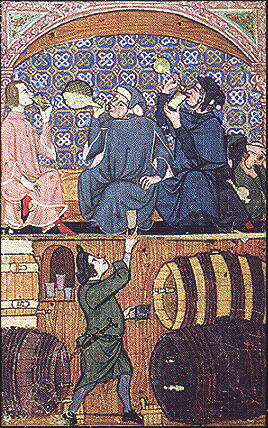Oshkosh author and historian Clarence “Inky” Jungwirth suggested that we ought to include a history of brewing on this site. Not only that, he was good enough to go ahead and write it. Here’s Inky’s history of beer.
 |
| Sumerian Beer Recipe, 3200 BC |
The Cities of Oshkosh and Milwaukee have been known since their founding for their large production and consumption of Beer, especially in the early years. One only has to look at their City Directories, especially those printed in the 19th Century and early 20th Century, to see the number of Taverns listed under the heading of either Sample Rooms or Bars or Taverns. The following is a History of Beer throughout the ages and is taken from various sources published many years ago.
Beer is an alcoholic beverage produced by extracting raw materials with water, boiling (usually with hops) and fermenting. In some countries beer is defined by law as in Germany where the standard ingredients are water, germinated barley, hops and yeast.
 |
| Egyptian Beer Brewing |
Before 6000 B.C., beer was made from barley in Sumeria and Babylonia. Reliefs on Egyptian tombs dating from 2400 B.C. show that barley or partly germinated barley was crushed, mixed with water, and dried into cakes. When broken up and mixed with water, the cakes gave an extract that was fermented by microorganisms accumulated on the surfaces of fermenting vessels.
The basic techniques of brewing came to Europe from the Middle East. The Roman Historians Pliny (in the first century B.C.) and Tacitus (in the First Century A.D.) reported that Saxons, Celts, Nordic and Germanic tribes drank ale. In fact, many of the English terms used in brewing (malt, mash, wort, ale) are Anglo-Saxon in origin.
 |
| A Medieval Tavern |
During the Middle Ages, the monastic orders preserved brewing as a craft. Hops were in use in Germany in the 11th Century, and in the 15th Century they were introduced into Britain from Holland. In 1420 beer was made in Germany by a bottom fermentation process (prior to this, top fermenting yeasts were the norm). Brewing was a winter occupation, and ice was used to keep beer cool during summer months. Such beer came to be called lager (from the German word "lagern" (to store). The term lager is still used to denote beer produced from bottom-fermenting yeast, and the term ale is used for top-fermented British types of Beer.
There have been beer lovers who get hangovers from too much beer drinking since ancient times. For 20th Century and 21st Century beer lovers the 19th Century Industrial Revolution perfected beer making as we have it today. It was also 19th century scientists such as Pasteur who helped in perfecting the process of preserving beer. The improvement of refrigeration processes in the late 19th and early 20th Century made the wide distribution of beer products available to the growing beer drinking public.
As we sit at the bar drinking a beer let us salute our ancient ancestors for inventing the nectar of the gods.









I just wanted to commend Inky Jungwirth on the tremendous job he has done researching and recording Oshkosh history. Had I known what a fascinating history Oshkosh had, I might have appreciated it more growing up. I'm glad I'm learning now. It's never too late.
ReplyDeleteMaybe he can do an article on the Nigl family. They had "Sample Houses" going way back. I've read some funny stories about their operations on the Oshkosh Highholders website.
I totally agree with you, Inky Jungwirth is an Oshkosh treasure. And getting to know him has been one of the best benefits of doing this blog. We’re going to have a couple more Inky articles coming up - one on Sheeny Steckbauer’s Tavern and another that will appear around the holidays about beer and Christmas. He also currently has two books in the works. He’s 90 years old and still holds a job! The guy is amazing.
ReplyDelete